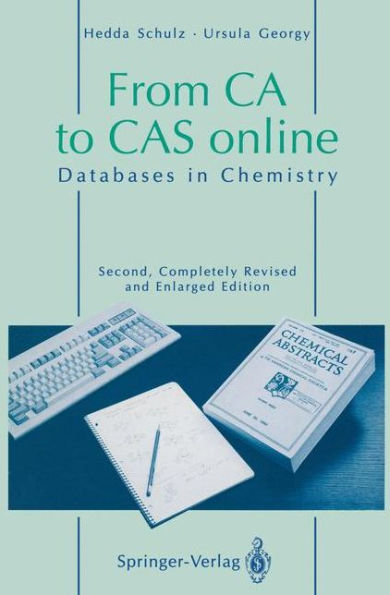Table of Contents
1 The Information System of the Chemical Abstracts Service.- 1.1 The History of Chemical Abstracts and of Secondary Literature.- 1.2 How an Abstract in Chemical Abstracts is Created.- 1.3 The Databases of the Chemical Abstracts Service.- 1.3.1 The Structure CAS Databases.- 1.3.2 The Bibliographic CAS Databases.- 2 Searching for Literature in Chemical Abstracts.- 2.1 Organization of Chemical Abstracts.- 2.1.1 CA Issues.- 2.1.1.1 The Abstracts.- 2.1.1.2 The CA Issue Indexes.- 2.1.2 Index Guide.- 2.1.3 CA Volume Indexes.- 2.1.3.1 General Subject Index.- 2.1.3.2 Chemical Substance Index.- 2.1.3.3 Formula Index.- 2.1.3.4 Index of Ring Systems.- 2.1.3.5 Author Index.- 2.1.3.6 Patent Index.- 2.1.4 CA Collective Indexes.- 2.2 Sample Search (to illustrate Index Guide, Chemical Substance Index, Qualifiers and Categories): What was published about the plasticizer DOS in Vol. 118?.- 2.3 Sample Search (to illustrate Alphabetical Hierarchy, Hierarchy Index of General Subject Headings, Qualifiers for Organs and Tissues and General Subject Index): Are there recent publications on the therapy of cardiac arrest?.- 2.4 Sample Search (to illustrate Index Guide, General Subject Index and Chemical Substance Index): Does Chemical Abstracts, Vol. 118 contain references about the Fischer-Tropsch synthesis?.- 2.5 Sample Search (to illustrate Molecular Formulae, Formula Index and Chemical Substance Index): What is the fastest method of finding abstracts about the substance with the molecular formula Cl3C-CO2Na?.- 2.6 Sample Search (to illustrate Patent Index, Numerical Patent Index and Patent Concordance): What are the contents of the patents US 5,158,840 and CH 609,340?.- 2.7 Sample Search (to illustrate Index Guide and Chemical Substance Indexes to the 12th to 1st collective period): Carry out a comprehensive search concerning the substance piceol.- 3 Locating the Source Document.- 3.1 CAS Source Index (CASSI).- 3.2 Sample Search (to illustrate short journal titles, CAS Source Index, library holdings information and English translations): Where can the English translation of the document covered in CA abstract No. 118:6467 be obtained?.- 4 Registry Handbooks.- 4.1 Registry Handbook — Number Section.- 4.2 Registry Handbook — Common Names.- 4.3 Sample Search (to illustrate Formula Index, Index of Ring Systems, Chemical Substance Index and Registry Handbook — Number Section): Were there any publications about a certain substance or any of its derivatives in the period from 1972 to 1976?.- 5 Ring Systems Handbook (RSH).- 5.1 Ring Systems File.- 5.2 Index to the Ring Systems Handbook.- 5.3 Sample Search (to illustrate Ring Systems Handbook and Chemical Substance Index): What was published about a certain ring system?.- 6 Online Searching.- 6.1 Technical Requirements.- 6.1.1 Communication Software.- 6.1.2 Data Transmission.- 6.1.3 Logon Procedure.- 6.1.4 Internet.- 6.2 An Introduction to Online Retrieval.- 6.2.1 Types of Databases and Access to Them.- 6.2.2 Processing a Query and Its Costs.- 6.2.3 Boolean Logical Operators and Other Proximity Operators.- 6.2.3.1 AND Operator.- 6.2.3.2 OR Operator.- 6.2.3.3 NOT Operator.- 6.2.3.4 Hierarchy of Logical Operators.- 6.2.3.5 Proximity Operators.- 6.2.4 Truncation.- 6.2.5 Indexing.- 6.2.6 Download of Documents.- 6.2.7 Hosts’ Mailboxes.- 6.2.8 A Simple Search.- 7 Chemical Databases on STN.- 7.1 Registry File — Dictionary Search.- 7.1.1 Registry Number and Component Registry Number.- 7.1.2 Trade Names and Chemical Names.- 7.1.3 Name Fragments.- 7.1.3.1 Heading Parent.- 7.1.3.2 Basic Index.- 7.1.3.3 Index Name Segment and Other Name Segment.- 7.1.3.4 Chemical Name Segment.- 7.1.4 Molecular Formulae.- 7.1.4.1 Multicomponent Systems.- 7.1.4.2 Compounds Containing Deuterium or Tritium.- 7.1.4.3 Polymers.- 7.1.5 Element Counts, Element Symbols and Formula Weights.- 7.1.6 Ring Analysis.- 7.1.7 Tabular Summary of Search Fields.- 7.1.8 Important Display Fields and Formats.- 7.2 Registry File — Structure Search.- 7.2.1 Types of Structure Search.- 7.2.2 Procedure of a Structure Search.- 7.2.3 Building up Structures.- 7.2.3.1 Building up of Structure Skeleton.- 7.2.3.2 Specifying Node Values.- 7.2.3.3 Bonds.- 7.2.3.4 Further Structure Attributes.- 7.2.3.5 Display of the Built-up Structure.- 7.2.4 Structure Search.- 7.2.5 Display of Answers.- 7.2.6 Screen Search.- 7.2.7 A Complete Structure Search with Spiro[cyclohexane-1,3?-[3H]indol] Derivatives as an Example.- 7.3 Chemical Abstracts.- 7.3.1 Crossfile Searching REGISTRY/CA File.- 7.3.1.1 Taking over the Registry Number.- 7.3.1.2 Taking over the Registry Number and Names.- 7.3.2 Basic Index.- 7.3.2.1 Substance Search with Registry Number and Subject Terms.- 7.3.2.2 Dictionary Search with Subject Terms.- 7.3.2.3 Default Abbreviations for Subject Terms.- 7.3.2.4 Search Registry Number and Subject Terms with the LINK Operator.- 7.3.3 Further Fields.- 7.3.3.1 Authors and Inventors.- 7.3.3.2 Corporate Sources, Patent Assignees and Locations.- 7.3.3.3 Document Type.- 7.3.3.4 Source, CODEN and ISSN.- 7.3.3.5 Publication Date and Year.- 7.3.3.6 Sections.- 7.3.3.7 Language of the Original Publication.- 7.3.3.8 Cross-References to Other Databases.- 7.3.4 Chemical Abstracts as a Patent Database.- 7.3.4.1 Patent Assignees and Inventors.- 7.3.4.2 Patent Number, Patent Country and Designated States.- 7.3.4.3 Application and Priority Information.- 7.3.4.4 International Patent Classification (IPC).- 7.3.5 Important Display Fields and Formats.- 7.4 World Patents Index from Derwent.- 7.4.1 Access to the Database.- 7.4.2. Crossfile Searching Chemical Abstracts/World Patents Index.- 7.4.3 Basic Index.- 7.4.4 Patent Assignees.- 7.4.5 Inventors.- 7.4.6 Patent and Priority Numbers.- 7.4.7 Country Information.- 7.4.8 Date Information.- 7.4.9 Patent Statistics.- 7.4.10 Important Display Fields and Formats.- 7.5 CApreviews.- 7.6 CAOLD.- 7.7 CASREACT.- 7.7.1 Reactants, Products, Reagents.- 7.7.2 Number of Reaction Steps.- 7.7.3 Yield.- 7.7.4 Important Display Fields and Formats.- 7.8 MARPAT.- 7.9 CIN — Chemical Industry Notes.- 7.9.1 Basic Index.- 7.9.2 Chemical Names.- 7.9.3 Categories.- 7.9.4 Names of Persons and Companies.- 7.9.5 Geographical Data.- 7.9.6 Further Chemical Business Databases.- 7.9.6.1 Chemical Business News Base.- 7.9.6.2 Predicasts Promt.- 7.10 Beilstein.- 7.10.1 Identification of Substance.- 7.10.2 Preparation and Reactions.- 7.10.3 Physical-Chemical Properties.- 7.10.4 Spectroscopic Data.- 7.10.5 Important Display Formats.- 7.11 Gmelin.- 7.11.1 Definition of Gmelin Compounds.- 7.11.2 Substance Identification.- 7.11.3 Preparation and Reactions.- 7.11.4 Physical-Chemical Properties.- 8 The Databases of Chemical Abstracts Service on Six Hosts.- 8.1 Special Features on Different Hosts.- 8.1.1 DATA-STAR.- 8.1.2 DIALOG.- 8.1.3 ESA-IRS.- 8.1.4 ORBIT Search Service.- 8.1.5 QUESTEL.- 8.1.6 STN.- 8.1.7 Summary of Available CAS-Databases and Search Features.- 8.1.8 Hosts’ Addresses.- 8.2 Comparison of Retrieval Commands.- 9 Printed Matter — Online Services, a Comparison.- 10 Conclusion.- 11 Bibliography.- 12 Glossary.- 13 Index.



